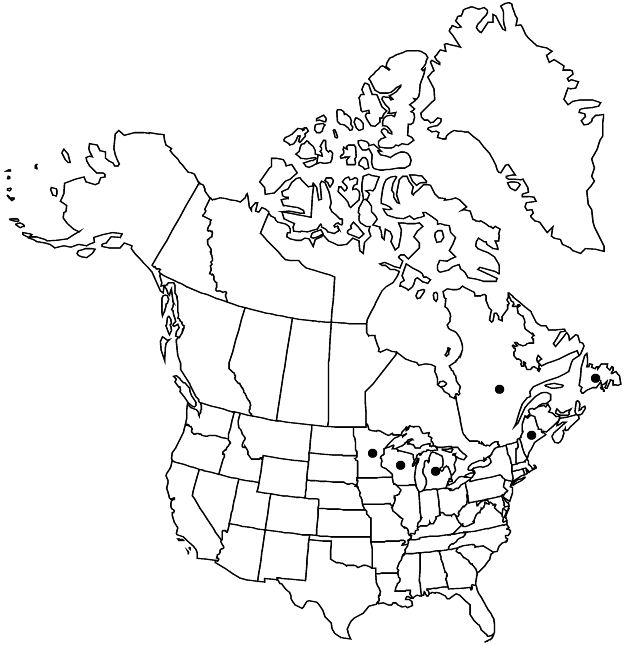Crataegus laurentiana
Rhodora 3: 77. 1901.
Shrubs, 30–50 dm. Stems: trunks much-branched, thick, stout; twigs strongly flexuous, stout, new growth light orange-green to dark green, tomentose, soon glabrescent, 1-year old bright orange-brown, very lustrous, older gray; thorns on twigs often retrorse, 1-year old lustrous chestnut brown to very dark red-brown, very stout, 5–7.5 cm. Leaves deciduous; stipules bright red before falling, lanceolate to oblanceolate, 8–15 mm, finely glandular-serrate; petiole often dark red after mid summer, stout to slender, length 40–50% blade, distally ± broadly winged, villous young, glabrescent, deeply grooved, sessile-glandular young, glands caducous, dark, small; blade in early spring yellow-green, dark green, abaxially paler, oblong to oblong-obovate or ovate to rhombic (suborbiculate in var. dissimilifolia), 4–6 cm, thin to subcoriaceous, base gradually or abruptly narrowed from near middle, lobes 4 or 5 per side, sinuses ± deep except in var. dissimilifolia, LII 20–33%, narrow, lobe apex acute, margins sharply glandular-serrate except proximally, venation craspedodromous, veins 5 per side, apex acute or acuminate, matte, abaxial surface with stout midvein, glabrous, rarely sparsely hairy, veins sparsely white villous, adaxial pale, short-appressed-hairy. Inflorescences 6–15-flowered, lax; branches hairy; bracteoles caducous, pallid bright red, linear, membranous, margins finely glandular-serrate. Flowers 15(–20) mm diam.; hypanthium externally pale, long-matted hairy at base, internally glabrate to puberulous; sepals reflexed, shorter than petals, narrow, margins conspicuously glandular-serrate, apex acuminate, abaxial surface glabrate, adaxial villous; stamens 10, anthers cream or pale pink, fading purple; styles 3–5. Pomes in drooping or erect infructescences, branches slightly villous, red to dark crimson, oblong to pyriform, 8–15 mm; flesh yellow, thin, becoming sweet and succulent; sepals prominent, appressed, with deep, wide cavity; pyrenes (3 or)4 or 5, thick, wide, 6 mm, dorsally prominently grooved, sides ± roughened, irregularly eroded or pitted.
Phenology: Flowering Jun; fruiting Sep–Oct.
Habitat: Brush, open woods, rocky pastures
Elevation: 20–200 m
Distribution

Nfld. and Labr. (Nfld.), Que., Maine, Mich., Minn., Wis.
Discussion
Crataegus laurentiana was considered a sporadic entity of the northeast and Wisconsin until the recent discovery of a large population in Minnesota.
Hybrid origin for Crataegus laurentiana between a ser. Macracanthae species and C. chrysocarpa in the broad sense, or C. jonesiae, is supported by intermediacy and sympatry of the suspected parents. Chrysocarpoid characteristics include leaf shape and glandular petioles; macracanthoid traits include late anthesis, pink anthers, and variably eroded pyrene sides.
Specimens from Newfoundland and Quebec are var. laurentiana and are characterized by larger but proportionately narrow leaves, thicker and paler twigs, and pink, normal-sized (1 mm) anthers. They may be distinguished from the partly sympatric var. brunetiana by the smaller and proportionately broader leaves of the latter, and cream anthers, more like Crataegus chrysocarpa. In both forms, the leaves abaxially have conspicuously appressed-pilose veins. A Maine variant is atypically arborescent.
The rare var. dissimilifolia Kruschke from northern Wisconsin has white-cream anthers but larger and more nearly isodiametric, shallowly incised leaves. Similar, also rare, plants from southern Manitoba have pink anthers. Stature and leaf size and shape in both of these place them outside the range of C. chrysocarpa; perhaps C. submollis is a parent.
Unnamed populations from a large area in northeastern Minnesota are the most biologically interesting. They are self-perpetuating and, compared to other forms, have more slender twigs that are generally very dark in their second year, like Crataegus macracantha, smaller leaves, somewhat impressed leaf venation, small (0.6 mm), pink anthers, and ellipsoid fruits.
Crataegus fernaldii is a rare form from Maine and Quebec with lax, elongated, extremely villous corymbs, large flowers (20 mm diam.), pink anthers, and large, pear-shaped fruits gracefully drooping in wide clusters on their long stems.
Selected References
None.